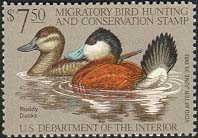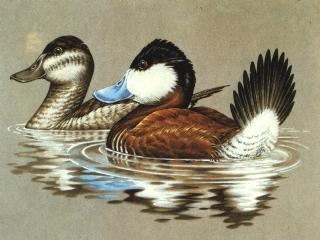

Back to RW48 Back to the Federal Index Home
A LITTLE HISTORY ON THE 48TH (1981-82) DUCK STAMP ARTIST


John S. Wilson's family was not much better off financially than many families during the depression. At his home in Sisseton, South Dakota, where he was born on June 6, 1939, he did enjoy one advantage over many of the poverty stricken people during that period. Just out he back door were large expanses of farmland and wilderness where he could hunt and fish.
When Mr. Wilson was 17 he enlisted in the United States Air Force where he remained until he was 25. For the first few years he was assigned to the crash rescue teams at Williams Air Force Base near Phoenix, Arizona. there he spent six years that were often grim and depressing, picking up the pieces left by pilot error or mechanical failure. Finally he worked his way into air installations and eventually was able to use his artistic skills by painting for the Air Force.
Soon after he left the service he accepted short-term employment to do a different kind of painting with a construction firm. while he was working for the company he met a pretty young bookkeeper named Alvis Chilson. They were married after a year of courtship and moved to Wahpeton, North Dakota.
He left the construction company while he was still enrolled in school and took a position with a sign company in Aberdeen, South Dakota. Later he arranged a transfer to Watertown, a quiet little village in the northeast corner of South Dakota, not too far from his birthplace. he remained with the company for 25 years.
For Mr. Wilson, painting was still a hobby to be practiced at night and on weekends. In fact, he did not paint any wildlife subjects until 1976 when the state of South Dakota instituted a mandatory Duck Stamp program. The state government began soliciting artists to enter the contest for the first design and Mr. Wilson decided to enter. His painting of a Trumpeter Swan took second place to a pair of Mallards by Robert Kusserow.
Fired with enthusiasm from this experience, he concentrated his efforts on painting the wildlife native to South Dakota and its bird in particular. The state changed the Duck Stamp to a Pheasant Restoration Stamp in 1979 and Mr. Wilson's painting of a pair of Ringed-necks placed first. He also won the top prize for his 1981 Pheasant Stamp design.
John Wilson is a quiet man, uninterested in the razzle-dazzle of city life. As much excitement as he ever hoped to experienced came on November 5, 1980 when his painting of a pair of Ruddy Ducks won the federal Duck Stamp contest. The Walleye is tops on his game-fish list and he usually can be found trying to catch the elusive prey when he's not painting. He says that hooking a Walleye makes him forget everything except the struggle between him and the fish, and he knows no better prescription for the pressure and strained nerves. The Wilson's have there children, Jill, Jeff, and Tom.
--------------------THE ART--------------------
Ruddy Ducks was painted in full-color gouache. It is a photomechanical photolithograph print. The work was printed in four colors in lightfast ink on Rives offset paper. It was hand signed and numbered in pencil. The edition in 16,000 prints and 400 artist proofs. The image size is 6-1/2" x 9".
--------------------THE STAMP--------------------
Ruddy Ducks…Engraved by the Federal Bureau of Engraving from the original artwork. Printed in yellow, orange, blue, grey, brown and black ink. The stamp sold for seven dollars and fifty cents. Postal records show 1,907,114 stamps sold. First day of sale was July 1, 1981.
Most of the information contained above is from the book Federal Duck Stamp Story, Fifty Years of Excellence, by Laurence F. Jonson; Alexander & Co. It is used here with permission from the author. For more information on this book, please click here.